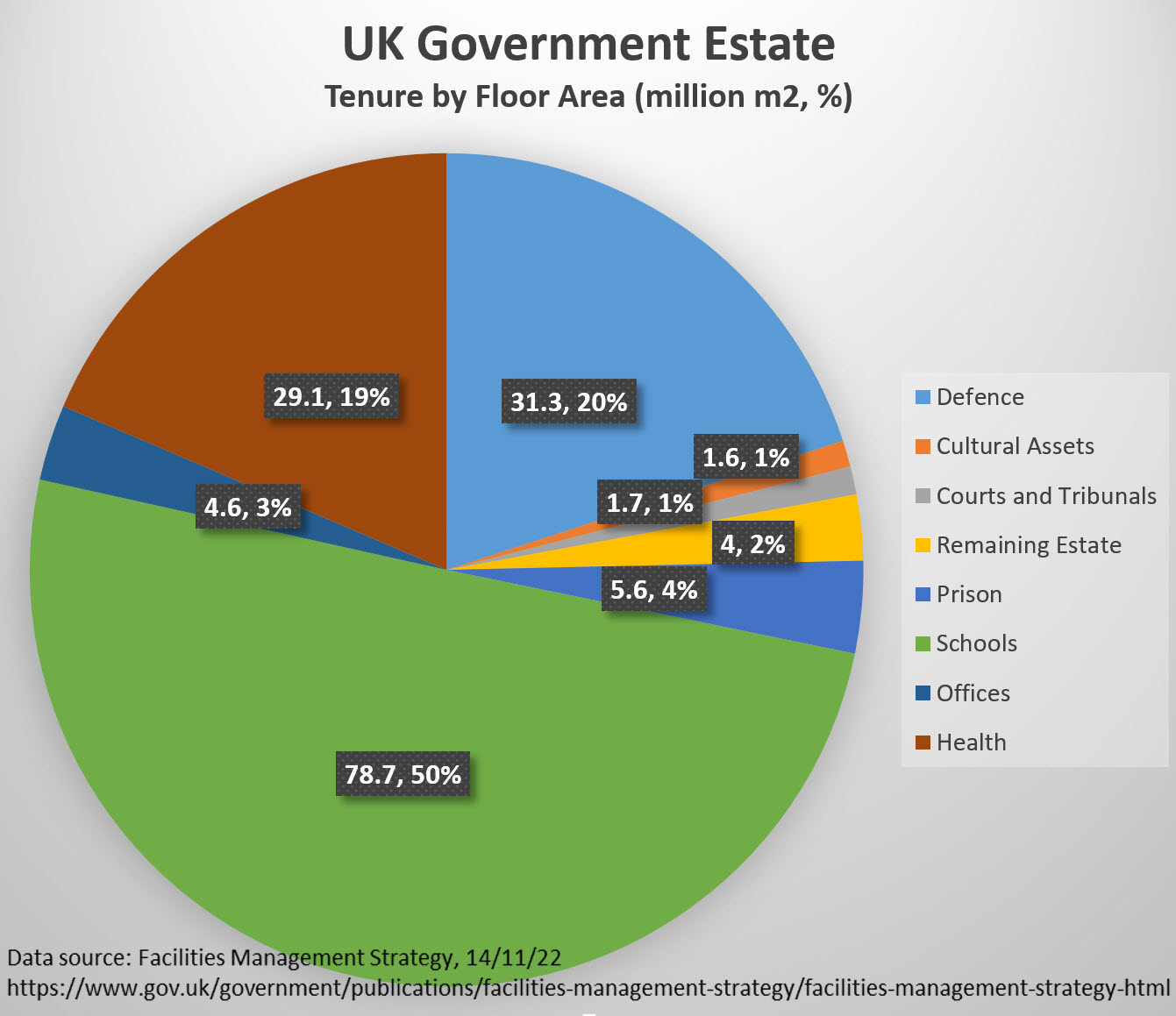This blog is a summary of the government Facilities Management Strategy which was released on the 14th November, 2022. A link to the full document is at the end of this blog.
While the government Facilities Management Strategy obviously focuses on the government’s estates it contains messages which are equally applicable to any facility manager irrespective of the sector being worked in. We’ve chosen to highlight some of these as you’ll see.
Introduction
The government estate is vast and diverse including courts, job centres, hospitals, schools, offices and much more. Facilities Management (FM) needs to cater for the wide range of facilities and services it supports and enables. There should be a level of consistency across Government, enabling comparisons and collective improvements.
FM has a major impact on how citizens and staff experience public services, and how staff engage with their workplace. If they are not provided successfully, to a high standard, there’s a visible impact on the quality of services – damaging operational delivery, productivity, sustainability, and health and safety.
Effective, efficient and safe buildings are critical to enable successful operational delivery to both the public accessing services and staff delivering them. Well managed facilities services, delivered to high quality standards, are a vital foundation for excellent public services and productive workplaces.
Key Statistics
The diverse nature of the government estate requires an estimated public spend on FM of £13bn which is 0 5% of UK GDP and is 18% of the total UK FM market of £65bn. The Ministry of Defence accounts for the largest share of spend (45.8%) followed by the Ministry of Justice (11.9%) and DWP (8.8%).
136,844 built assets
£21.7 billion annual running costs
Asset condition – 61% Good / Satisfactory
£157.6 billion value
Tenure by floor area m2
85% Freehold
7% Leasehold *6% PFI
2% Other
156.8 million m2 – Floor Area (Gross Internal Area) split across the sectors shown in the pie chart shown below.

Due to long-term under investment along with inconsistent and varied approaches to the management of the government estate, the condition has over a number of years deteriorated to the point where functionality was becoming affected.
The government facilities management strategy addresses how FM will support the ongoing transformation and increased digitalisation of public services, and developing new ways of working for public servants. The workplace can bring a positive impact on productivity, and the condition of the estate can improve recruitment and retention of talented people. A whole life asset management approach to maintenance can build value, reduce liabilities, and ensure longevity of the estate.
The strategy recognizes that Covid highlighted the important role FM staff have in creating places where people can work productively and safely receive public services. FM was centre stage and recognised for the value it brings to everyone’s lives and the contribution it makes to organisational success.
Vision, Values and Goals
Vision for 2030
Through the delivery of facilities management across government the strategy will create an estate which: Enhances Lives, Enables Success and Ensures Value, with accessible and responsive spaces, skilled professionals and quality services.
Values
The strategy is focused on the following values:
Enhancing Lives
Members of the public visit buildings for a multitude of reasons throughout their lives, often at times of crisis or stress. Workplace environments must support staff wellbeing and allow them to be at their most productive. Buildings must be greener, healthier and more sustainable, with positive impacts on nature and biodiversity.
Every experience of FM in government buildings must be a positive one.
Enabling Success
FM is delivered by a diverse mix of individuals and organisations. This diversity and the potential it has for innovation must be embraced.
Staff delivering services must have a solid foundation to build their careers. Staff need the right environment, tools and technology to allow them to fully utilise their skills and capabilities.
Regardless of delivery model, FM must be delivered professionally and seamlessly as if by one team.
Ensuring Value
Value is not cost.
FM organisations need to understand what their users require and how to effectively manage and leverage data to improve customer service experiences. Maintenance choices need to account for where a building is on its lifecycle journey and target investment accordingly. Contracts must deliver societal as well as financial benefits.
FM must demonstrate the value it provides to all stakeholders and society.
Goals
The following strategic goals for FM have been set:
|
VALUE |
GOAL |
|
Enhancing Lives |
1. Frontline delivery from accessible and responsive places. 2. Flexible and inclusive services in supportive workplaces 3. Sustainability at the forefront of all FM activities |
|
Enabling Success |
4. FM professionals equipped with effective skills and capabilities 5. Effective standards, tools, technology and organisation 6. Metrics that measure real-world performance |
|
Ensuring Value |
7. An holistic approach to asset management 8. Standardised and assured FM data and analysis 9. Assured FM contracts delivering quality service |
Please refer to the strategy document which goes into each of these value areas in more detail and includes case studies.
For now let’s take a deeper dive into Ensuring Value…
Ensuring Value
FM must demonstrate the value it provides to all stakeholders and society.
FM has a key role in supporting strategic asset management and a whole life cost approach to property strategies and investment decisions. Maintenance strategies across government organisations are currently variable.
Delaying maintenance by between 2 and 4 years can multiply the cost by between 1.5 to 2.0 times. To expect positive change, improvements in the use of FM asset and end user satisfaction data need to be implemented.
At the start of the strategy period 61% of the Government estate is graded as being in Good or Satisfactory condition. The Government Functional Standard for Property requires that organisations carry out regular condition surveys of their estates. Without this, property teams will be unable to prioritise capital investment decisions resulting in deterioration of the government estate.
Key to managing FM assets successfully is a comprehensive asset data register, broken down into individual components. Currently management of asset information is variable across organisations impacting on the cost and quality of services. It’s essential to implement systems and processes to deliver this work which is pivotal to all FM service delivery.
In addition to asset data, FM services generate a vast amount of data particularly when computer aided FM (CAFM) systems are deployed. The current primary use of this data is the generation of key performance indicator scores used to measure supplier performance. Fuller utilisation of this information will lead to service improvements and cost savings. Ensuring that there is the capacity as well as the capability to use this data is key to maximising the potential of CAFM systems.
The levelling up white paper supports reservation of smaller contracts for UK suppliers to prioritise growth and productivity in the UK. Historically the government has tended to award very large FM contracts covering wide geographic areas.
The buying power of the government may be leveraged by bundling together, where appropriate, parts of the central government estate on a geographical basis potentially benefiting smaller and more local providers. Organisations will develop FM specifications and contact management arrangements to achieve business operational objectives with value, including social value, professional qualifications and transparency being assured through the Cabinet Office FM Control.
By 2025 the strategy will have ensured the:
- Embedding of whole life asset management methodologies into all lifecycle replacement and maintenance investment decisions
- Implementation of the FM standard FMS 002 Asset Data
- Development of FM management organisations’ data analysis capability
- Use of the FM Control and procurement processes to widen assurance across all government FM contracts
Follow this link to access the full UK Government Facilities Management Strategy document, which includes illustrative case studies.
Discover how Altuity’s CAFM – AltoSites – can help you, your team and stakeholders meet your facilities management needs.

